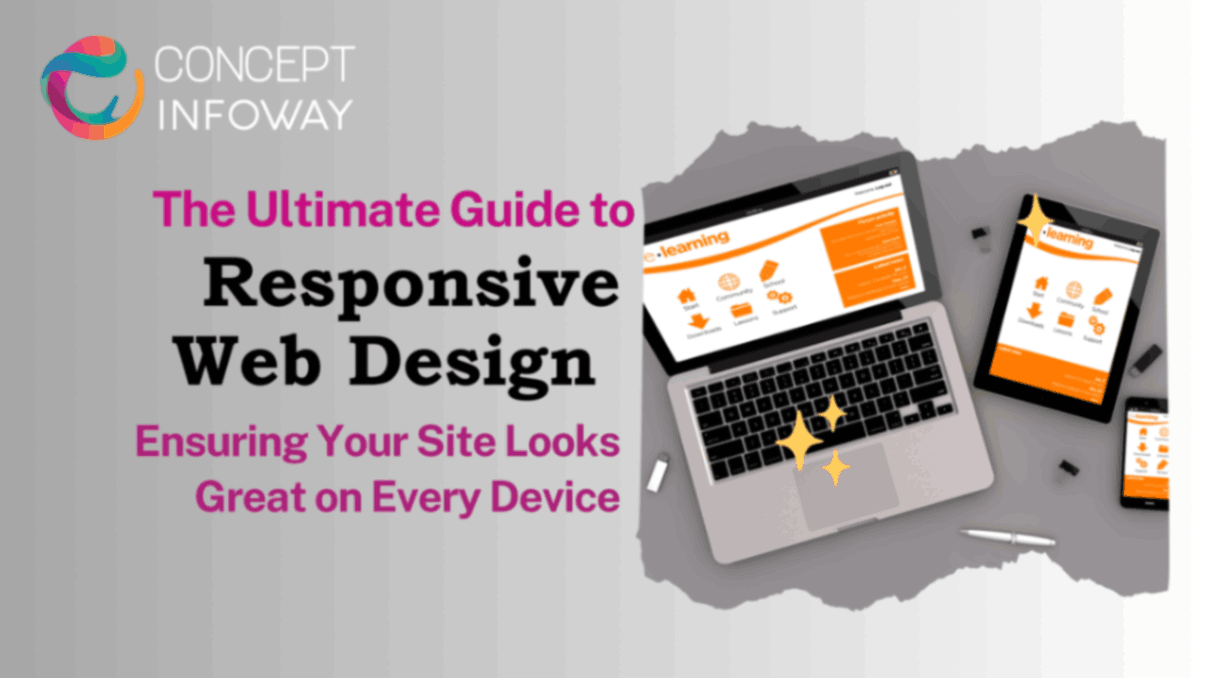
The Ultimate Guide to Responsive Web Design: Ensuring Your Site Looks Great on Every Device
In today’s digital age, where mobile devices have become an integral part of our lives, responsive web design has emerged as a critical component of a successful online presence. A responsive website is designed to adapt seamlessly to different screen sizes and orientations, ensuring a consistent and optimal user experience across all devices.
The Importance of Responsive Web Design in Today’s Mobile-First World
The proliferation of smartphones and tablets has transformed the way people consume content online. A significant portion of internet traffic now originates from mobile devices, making it imperative for businesses to have websites that are optimized for these platforms. Responsive web design is essential to cater to this growing trend and ensure that your website is accessible and engaging to a wider audience.
Benefits of Mobile-Friendly Design
Improved User Experience: Responsive websites provide a seamless and consistent experience across all devices, enhancing user satisfaction and engagement.
Better SEO: Search engines prioritize mobile-friendly websites, so responsive design can improve your search engine rankings and visibility.
Increased Conversions: A responsive website can lead to higher conversion rates as it makes it easier for users to navigate, find information, and act on mobile devices.
Cost-Effective: Responsive design eliminates the need for separate mobile and desktop websites, saving time and resources.
Enhanced Brand Reputation: A user-friendly website demonstrates your commitment to providing a quality user experience, positively impacting your brand’s reputation.
Understanding Responsive Design Principles
Responsive web design is based on the concept of fluid layouts, which adapt to different screen sizes using CSS media queries. This means that the website’s elements, such as images, text, and layouts, adjust dynamically to fit the specific device being used.
Key components of Cross-platform design include:
Fluid Grid Layout: A flexible grid system that allows elements to rearrange and resize based on screen width.
Media Queries: CSS rules that allow you to apply different styles based on the device’s screen size, orientation, and other characteristics.
Responsive Images: Optimizing images to load efficiently on different screen sizes and resolutions.
Flexible Typography: Using responsive typography techniques to ensure text is legible and readable on various devices.
By understanding these principles, you can effectively design and implement responsive websites that provide a superior user experience across all platforms.
Benefits of Responsive Web Design
Improved User Experience: Responsive websites offer a better user experience as they are designed to fit the screen size and resolution of the device being used. This eliminates the need for zooming or scrolling, making it easier for users to navigate your site.
Enhanced SEO: Search engines prioritize mobile-friendly websites. A responsive website can improve your search engine rankings, making it easier for potential customers to find you online.
Increased Conversions: Responsive websites can lead to higher conversion rates as they provide a better user experience, making it more likely for visitors to take desired actions, such as making a purchase or signing up for a newsletter.
Cost-Effective: Mobile-first design is a cost-effective solution as it eliminates the need for separate mobile and desktop websites.
Best Practices for Responsive Web Design
To ensure your website looks great on all devices, it is essential to follow these best practices:
Use a responsive framework: Frameworks like Bootstrap and Foundation provide pre-built components and styles that make it easier to create responsive websites.
Optimize images for different screen sizes: Use responsive images that adjust their size based on the screen resolution to improve loading times and provide a better user experience.
Design for mobile first: Start designing your website for mobile devices and then adapt it for larger screens. This ensures that your content is optimized for smaller screens and provides a good foundation for larger screens.
Prioritize content over Style: Focus on delivering valuable content rather than prioritizing visual elements. A clean and uncluttered design is essential for a good user experience.
Test across multiple devices and browsers: Test your website on a variety of devices and browsers to ensure it works as expected on all platforms.
Hire Web Designers?
Get a Free Quote
Essential Responsive Design Techniques
Fluid grids and flexible layouts: Use flexible grids and layouts that adjust to different screen sizes.
Responsive images: Use responsive images that automatically adjust their size based on the screen resolution.
Media queries and breakpoints: Use media queries to define different styles for different screen sizes.
CSS techniques: Utilize CSS techniques like Flexbox and Grid to create responsive layouts.
Tools and Resources for Responsive Web Design
To effectively implement responsive web design, it is essential to have the right tools and resources at your disposal. Here are some of the most valuable tools and resources that can aid in the development and testing of responsive websites:
Browser Developer Tools
Chrome DevTools: A powerful set of tools built into the Chrome browser that allows you to inspect and edit HTML, CSS, and JavaScript code.
Firefox Developer Tools: Like Chrome DevTools, Firefox Developer Tools provide a comprehensive set of tools for web development.
Safari Web Inspector: The built-in web inspector in Safari allows you to examine and modify the HTML, CSS, and JavaScript of a webpage.
Edge DevTools: Microsoft Edge’s developer tools offer a similar set of features to Chrome and Firefox DevTools.
These tools are invaluable for debugging responsive layouts, inspecting CSS styles, and testing your website on different screen sizes and orientations.
Responsive Design Testing Tools
Google Mobile-Friendly Test: This free tool from Google allows you to quickly check if your website is mobile-friendly. It provides insights into potential issues that may affect the user experience on mobile devices.
Browser Stack: Browser Stack is a cloud-based testing platform that provides access to a wide range of real devices and browsers. It allows you to test your website on different screen sizes, operating systems, and network conditions.
Responsive Design Checker: This online tool allows you to quickly test your website’s responsiveness across different devices and screen sizes.
Design Tools
Sketch: A popular design tool for creating wireframes, mockups, and prototypes. It offers a wide range of features and integrations for designing responsive websites.
Figma: A cloud-based design tool that allows for real-time collaboration and prototyping. Figma is well-suited for designing responsive layouts and user interfaces.
Responsive Design Frameworks and Libraries
Bootstrap: A popular responsive design framework that provides a collection of pre-built components and styles for creating responsive websites.
Foundation: Another popular responsive design framework with a focus on flexibility and customization.
Materialize: A responsive design framework inspired by Google’s Material Design language.
Semantic UI: A responsive design framework that emphasizes semantic HTML and CSS.
By utilizing these tools and resources, you can streamline the responsive web design process, ensure your website looks great on all devices, and provide a superior user experience.
Why Choose Concept Infoway LLC for Your Responsive Web Design Needs
When it comes to implementing responsive web design, partnering with a reputable Responsive Web Design Company can make a significant difference. Concept Infoway LLC is a leading provider of responsive web design services that offers a comprehensive range of solutions to help businesses create visually stunning and user-friendly websites.
Here’s why you should choose Concept Infoway LLC for your responsive web design needs:
Experienced Team of Web Designers
Our team of skilled web designers has years of experience in creating Mobile-first web design solutions that are both visually pleasing and functional. We stay up to date with the latest trends and technologies in the industry, ensuring that your website is always at the forefront of design.
Customized Responsive Design Solutions
We understand that every business has unique needs and requirements. That’s why we offer custom responsive web design solutions tailored to your specific goals. Our team will work closely with you to understand your brand, target audience, and desired outcomes, and then create a responsive design that perfectly aligns with your vision.
User-Centric Approach
At Concept Infoway LLC, we believe that a great website is one that puts the user first. Our responsive web design solutions are designed to provide a seamless and intuitive user experience across all devices. We focus on creating websites that are easy to navigate, load quickly, and provide valuable content to your visitors.
Responsive Web Design Best Practices
Our team adheres to the latest responsive web design best practices to ensure that your website is optimized for performance, accessibility, and search engine optimization (SEO). We use responsive frameworks, optimize images, and test your website on a variety of devices to ensure it looks and functions flawlessly on all screens.
Comprehensive Responsive Web Design Services
In addition to responsive web design, we offer a range of other services to help you create a successful online presence. These services include:
Website development: Creating custom websites that meet your specific business needs.
Web design: Designing visually appealing and user-friendly websites.
SEO optimization: Improving your website’s search engine rankings.
Content creation: Developing high-quality content for your website.
Digital marketing: Promoting your website through various online channels.
Affordable Pricing
We offer competitive pricing for our responsive web design services, making it affordable for businesses of all sizes. Our goal is to provide exceptional value and help you achieve your online marketing goals.
By partnering with Concept Infoway LLC, you can be confident that your website will be designed to look great and perform seamlessly on all devices. Contact us today to learn more about our responsive web design services and how we can help you take your online presence to the next level.
Conclusion
Mobile-first design is no longer an option; it’s a necessity in today’s mobile-first world. By ensuring your website looks and functions flawlessly on all devices, you can provide a superior user experience, improve your search engine rankings, and increase conversions.
Implementing responsive web design requires careful planning and execution. By following the best practices outlined in this guide and utilizing the recommended tools and resources, you can create a responsive website that delivers stunning visuals and a seamless user experience.
If you’re looking for expert assistance with Mobile-first design, consider partnering with a reputable Responsive Web Design Company. Responsive Web Design Companies near you can provide tailored solutions to meet your specific needs and ensure your website is optimized for all devices.
Don’t wait any longer. Invest in Adaptive web design and unlock the full potential of your online presence.
Call Us Today!
+1 832 290 9522
Frequently Asked Questions – FAQs
Responsive web design is a technique that ensures a website looks and functions well on all devices, from smartphones to desktops. This means that the website automatically adjusts its layout and content to fit the screen size and orientation of the device being used.
The three basic things required for responsive web design are:
A Fluid Grid Layout: This allows the website’s content to adjust to different screen sizes.
Media queries: These are CSS rules that allow you to specify different styles for different screen sizes.
Responsive Images: Images should be optimized to load quickly and display correctly on all devices.
A website that looks and functions well on both desktop and mobile devices is an example of responsive design. For instance, if you visit a website on your smartphone and then view the same website on your desktop, the layout should adjust to fit the screen size and provide a seamless user experience.
Yes, responsive design is still a crucial aspect of web development. With the increasing number of people using mobile devices to access the internet, it is essential for websites to be responsive to provide a good user experience and improve search engine rankings.
Responsive design in UI/UX ensures a website adapts to various screen sizes and devices, offering consistent and seamless experiences. Concept Infoway LLC specializes in responsive web design, creating interfaces that enhance usability and improve user engagement across mobile, tablet, and desktop platforms.
Making a website responsive can be challenging without the right tools and experience. Concept Infoway LLC simplifies the process by using advanced frameworks and proven design techniques to ensure your site looks great and functions flawlessly on any device.
Yes, responsive web design is essential for delivering a positive user experience, improving SEO rankings, and increasing conversions. Concept Infoway LLC builds responsive websites that are fast, visually engaging, and accessible—maximizing your digital impact.


